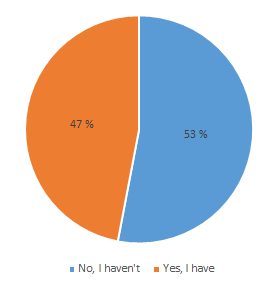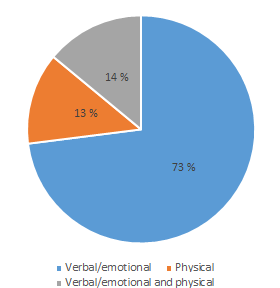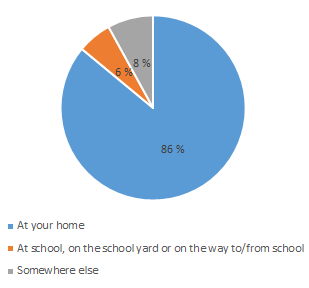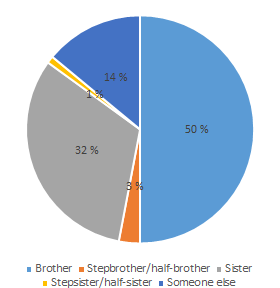Text and charts: Kaisa Järvelä
Young Person Most Likely to Be Hit by Brother
Child Victim Survey 2013 and Juvenile Delinquency in Finland 2012 chart young people's experiences of violence, crime and bullying.
Nearly half of Finnish adolescents (47%) have bullied other pupils at school or on the way to school or home. Roughly the same number of adolescents (46%) have experienced bullying. The majority of those who had bullied others (73%) reported to having resorted to verbal and emotional bullying instead of physical abuse.
The percentages are based on the Juvenile Delinquency in Finland 2012 survey conducted by the Institute of Criminology and Legal Policy. In the survey, 4,059 sixth-graders and 4,855 ninth-graders in Finnish schools responded to a number of questions about their circumstances and criminal behaviour.

Have you ever bullied another young person at school or on the way to/from school?

The last time you bullied another young person, was the bullying: verbal/emotional, physical, verbal/emotional and physical?
The Institute of Criminology and Legal Policy (previously National Research Institute of Legal Policy) has conducted national delinquency studies since 1995. The previous six studies were targeted only at ninth-graders, and sixth-graders were included in the survey for the first time in the spring 2012 collection round. The comparative data showed that criminal activities were considerably rarer among sixth-graders than ninth-graders (Venla Salmi & Karoliina Suonpää: Katsaus varhaisnuorten rikoskäyttäytymiseen ja uhrikokemuksiin 2012. OPTL Verkkokatsauksia 33/2013).
Bullying was also less prevalent among sixth-graders than ninth-graders. The percentage of ninth-graders who admitted to ever having bullied another young person was 52%, while for sixth-graders the percentage was 40%. The respondents were also asked whether they had bullied another young person in the previous 12 months. In this question however, the difference between sixth and ninth-graders was almost negligible: 19% of sixth-graders and 20% of ninth-graders responded in the affirmative.
The main focus in Juvenile Delinquency surveys is on the offences and crimes committed by adolescents themselves, but it also includes questions about their experiences of being a victim of crime. The survey presented 17 offences and violations, and asked which of them the respondents had committed as well as whether they had been a victim of any of the nine offences or violations presented. The violations and offences presented included, for instance, truancy, alcohol and drug use, bullying, and theft.
Young people face peer violence usually at home
Child Victim Survey 2013 charted adolescent and preadolescent experiences of violence, crime and bullying. The survey was jointly conducted by the Police University College and Finnish Youth Research Society in autumn 2013, and 11,364 young people (sixth and ninth graders) in Finnish and Swedish-speaking schools in Finland responded.
The results reveal that young people become victims of peer violence predominantly at home rather than at school or on the way to or from school. As many as 87% of the respondents who had experienced peer violence reported that it had happened in their own home. Only six percent of the respondents who had recently experienced violence had experienced peer violence at school or on the way to/from school.

Where did your sister, brother or other peer hit you or attack you?

Hit or attacked by siblings/peers - who was the (main) perpetrator?
In a clear majority of cases, the young perpetrator of violence was a family member of the victim. In 86% of the cases, the perpetrator was the victim's brother, sister, stepbrother or stepsister. In half of all the cases, peer violence was committed by the victim's brother and in 32% of the cases the victim's sister.
Young people willing to share their experiences
The Police University College has conducted Child Victim Surveys since 2008. In addition to peer violence, the 2013 survey investigated experiences of domestic violence, sexual abuse, assaults, violence in instructed activities, theft, robbery, and cyber harassment. Questions were also presented about situations where the respondents themselves had not been the victim but had to witness, for instance, violence against their family members.
The survey of 2013 also charted, for the first time, whether the respondents had told an adult or a friend about their experience of being a victim of a crime. Based on the responses, nearly a quarter of young people (24%) had not told anyone about their experience, while 59% had been able to tell at least their mother, 37% their father, and 28% their friends.
Most of the young people (71%) who had not told others about their experience reported that they did not consider the incident serious enough to be talked about. Out of those who had not shared their experience with anyone, only 5% had kept the experience a secret for fear or shame. Generally, it appears that young people can talk about their experiences of victimhood fairly well if they think the matter is serious enough.
Both the Juvenile Delinquency in Finland surveys and Child Victim Surveys are based on the self-report technique, which is needed because not all crimes are reported to the police and end up in crime statistics. The surveys also chart forbidden or questionable activities that are not explicitly covered by the law. In the Juvenile Delinquency survey, for instance, the respondents were asked about their attitudes towards lying to teachers and parents.
Both surveys were conducted as anonym online surveys at the respondents' schools during classes supervised by contact teachers.
The survey data are archived at the Finnish Social Science Data Archive. Child Victim Survey data are available for research, teaching and study, and Juvenile Delinquency in Finland data are available for research as well as Master's, licentiate and doctoral theses.
Data
- Child Victim Survey 2013. Ellonen, Noora & Fagerlund, Monica & Kääriäinen, Juha & Peltola, Marja & Sariola, Heikki: Child Victim Survey 2013 [computer file]. FSD2943, version 1.0 (2015-03-16). Helsinki: Ministry of Justice & Helsinki: Ministry of Education and Culture & Helsinki: Ministry of the Interior & Helsinki: Ministry of Social Affairs and Health [producers], 2013. Tampere: Finnish Social Science Data Archive [distributor], 2015.
- Juvenile Delinquency in Finland 2012. Kivivuori, Janne & Salmi, Venla: Nuorisorikollisuus 2012 [computer file]. FSD2976, version 1.0 (2015-05-08). Helsinki: National Research Institute of Legal Policy [producer], 2012. Tampere: Finnish Social Science Data Archive [distributor], 2015.
